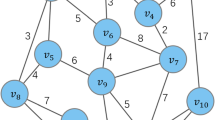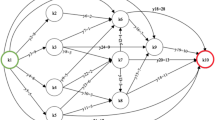Abstract
We consider the maximum shortest path interdiction problem by upgrading edges on trees under Hamming distance (denoted by (MSPITH)), which has wide applications in transportation network, network war and terrorist network. The problem (MSPITH) aims to maximize the length of the shortest path from the root of a tree to all its leaves by upgrading edge weights such that the upgrade cost under sum-Hamming distance is upper-bounded by a given value. We show that the problem (MSPITH) under weighted sum-Hamming distance is NP-hard. We consider two cases of the problem (MSPITH) under unit sum-Hamming distance based on the number K of critical edges. We propose a greedy algorithm within \(O(n+l\log l)\) time when \(K=1\) and a dynamic programming algorithm within \(O(n(\log n+K^3))\) time when \(K>1\), where n and l are the numbers of nodes and leaves in a tree, respectively. Furthermore, we consider a minimum cost shortest path interdiction problem by upgrading edges on trees under unit Hamming distance, denoted by (MCSPITUH) and propose a binary search algorithm within \(O(n^4\log n)\) time, where a dynamic programming algorithm is executed in each iteration to solve its corresponding problem (MSPITH). Finally, we design numerical experiments to show the effectiveness of the algorithms.





Similar content being viewed by others
References
Ahuja, R.K., Magnanti, T.L., Orlin, J.B.: Network Flows. Prentice-Hall, Englewood Cliffs, NJ (1993)
Albert, R., Jeong, H., Barabasi, A.: Error and attack tolerance of complex networks. Nature 406(6794), 378–382 (2000)
Khachiyan, L., Boros, E., Borys, K., Elbassioni, K., Gurvich, V., Rudolf, G., Zhao, J.: On short paths interdiction problems: total and node-wise limited interdiction. Theory Comput. Syst. 43(2), 204–233 (2008)
Corley, H.W., Sha, D.Y.: Most vital links and nodes in weighted networks. Oper. Res. Lett. 1, 157–161 (1982)
Bar-Noy, A., Khuller, S., Schieber, B.: The complexity of finding most vital arcs¡¡ and nodes, Technical Report CS-TR-3539. University of Maryland, Department of Computer Science (1995)
Nardelli, E., Proietti, G., Widmyer, P.: A faster computation of the most vital edge of a shortest path between two nodes. Inf. Process. Lett. 79(2), 81–85 (2001)
Frederickson, G.N., Solis-Oba, R.: Increasing the weight of minimum spanning trees. In: Proceedings of the 7th ACM–SIAM Symposium on Discrete Algorithms (SODA 1996), 539–546, (1996)
Bazgan, C., Toubaline, S., Vanderpooten, D.: Efficient determination of the $k$ most vital edges for the minimum spanning tree problem. Comput. Oper. Res. 39(11), 2888–2898 (2012)
Pettie, S.: Sensitivity analysis of minimum spanning tree in sub-inverse- Ackermann time. In: Proceedings of 16th international symposium on algorithms and computation (ISAAC 2005), Lecture notes in computer science, 3827, 964–73, (2005)
Iwano, K., Katoh, N.: Efficient algorithms for finding the most vital edge of a minimum spanning tree. Inf. Process. Lett. 48(5), 211–213 (1993)
Liang, W.: Finding the $k$ most vital edges with respect to minimum spanning trees for fixed $k$. Dis. Appl. Math. 113(2–3), 319–327 (2001)
Zenklusen, R., Ries, B., Picouleau, C., Werra, D., Bentz, C., de Costa, M.: Blockers and transversals. Dis. Math. 309(13), 4306–4314 (2009)
Zenklusen, R.: Matching interdiction. Dis. Appl. Math. 158(15), 1676–1690 (2010)
Bazgan, C., Toubaline, S., Vanderpooten, D.: Critical edges for the assignment problem: complexity and exact resolution. Oper. Res. Lett. 41, 685–689 (2013)
Ries, B., Bentz, C., Picouleau, C., Werra, D., Zenklusen, R., de Costa, M.: Blockers and transversals in some subclasses of bipartite graphs: when caterpillars are dancing on a grid. Dis. Math. 310(1), 132–146 (2010)
Zenklusen, R.: Network flow interdiction on planar graphs. Dis. Appl. Math. 158(13), 1441–1455 (2010)
Altner, D.S., Ergun, Z., Uhan, N.A.: The maximum flow network interdiction problem: valid inequalities, integrality gaps and approximability. Oper. Res. Lett. 38, 33–38 (2010)
Bazgan, C., Toubaline, S., Vanderpooten, D.: Complexity of determining the most vital elements for the p-median and p-center location problems. J. Combin. Optim. 25(2), 191–207 (2013)
Bazgan, C., Nichterlein, A., et al.: A refined complexity analysis of finding the most vital edges for undirected shortest paths: algorithms and complexity. Lecture Notes Comput. Sci. 9079, 47–60 (2015)
Zhang, H.L., Xu, Y.F., Wen, X.G.: Optimal shortest path set problem in undirected graphs. J. Combin. Optim. 29(3), 511–530 (2015)
Ertugrl, A., Gokhan, O., Cevriye, T.G.: Determining the most vital arcs on the shortest path for fire trucks in terrorist actions that will cause fire. Commun. Fac. Sci. Univ. Ank. Ser. A1 Math. Stat. 68(1), 441–450 (2019)
Zhang, Q., Guan, X.C., Pardalos, P.M.: Maximum shortest path interdiction problem by upgrading edges on trees under weighted $l_1$ norm. J. Global Optim. (2020). https://doi.org/10.1007/s10898-020-00958-0
Mohammadi, A., Tayyebi, J.: Maximum capacity path interdiction problem with fixed costs. Asia Pacific J. Oper. Res. 36(4), 1950018 (2019)
Zhang, B.W., Guan, X.C., Pardalos, P.M., et al.: An algorithm for solving the shortest path improvement problem on rooted trees under unit hamming distance. J. Optim. Theory Appl. 178, 538–559 (2018)
Papadimitriou, C.H., Steiglitz, K.: Combinatorial optimization: algorithms and complexity, Dover Publications, the second edition, (1988)
Author information
Authors and Affiliations
Corresponding author
Additional information
Publisher's Note
Springer Nature remains neutral with regard to jurisdictional claims in published maps and institutional affiliations.
Research is supported by National Natural Science Foundation of China (11471073) and the Basic Research Program at the National Research University Higher School of Economics (HSE) for P. M. Pardalos.
Rights and permissions
About this article
Cite this article
Zhang, Q., Guan, X., Wang, H. et al. Maximum shortest path interdiction problem by upgrading edges on trees under hamming distance. Optim Lett 15, 2661–2680 (2021). https://doi.org/10.1007/s11590-020-01687-9
Received:
Accepted:
Published:
Issue Date:
DOI: https://doi.org/10.1007/s11590-020-01687-9




